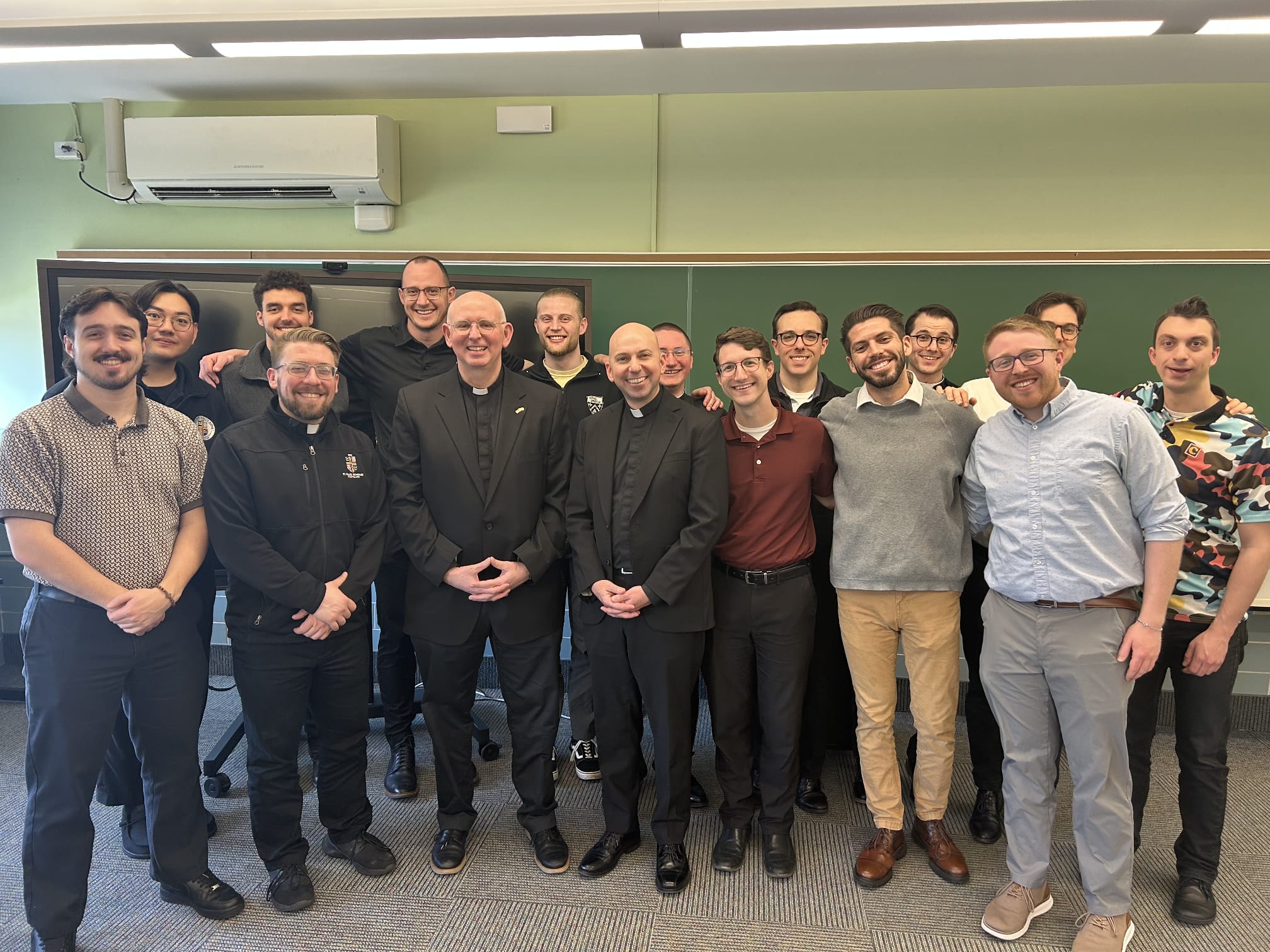
On Friday, March 14, seminarians and faculty members at St. Mary Seminary in the Diocese of Cleveland gathered to hear Father Anthony D. Andreassi, C.O. speak on the missionary nature of the Church and the role of The Pontifical Mission Societies. Introduced by Father Andrew Turner, the rector of the seminary, Father Andreassi’s talk highlighted the indispensable role of missionary animation in the Church and the duty of future priests to foster and support this mission.
Father Turner, in his introduction, connected the theme of reverence—a focal point of this year’s rector’s conferences—to reverence for the Church’s missionary call. “We recognize our reverence for God extends into reverence for others,” he said, acknowledging the Diocese of Cleveland’s long-standing missionary presence in El Salvador since 1964. “We know the importance of missionary animation and support.”
Father Andreassi, who currently serves as the national director of the Society for the Propagation of the Faith in the United States, began with a touch of humor, acknowledging that his talk was the only thing standing between the seminarians and a Friday evening sunset. As a former high school teacher, he understood well the energy of an audience at the week’s end. He then shared his own journey to The Pontifical Mission Societies, emphasizing that much of what he now knows about the Church’s mission work was new to him just two years ago.
Reflecting on the Diocese of Cleveland’s missionary commitment, Father Andreassi underscored its historic relationship with El Salvador. “For 61 years now, Cleveland has sent missionaries, and your diocese has literally contributed blood for the life of the Church,” he said, recalling the 1980 martyrdom of Cleveland’s missionary priests, including Blessed Stanley Rother, who laid down their lives in service to the people of El Salvador.
Father Andreassi then shifted focus to the global scale of the Church’s missionary work, sharing an eye-opening statistic from Cardinal Luis Antonio Tagle at the National Eucharistic Congress in 2024. “Sixty percent of the world’s population lives in Asia, yet only four percent are Catholic. Half of those Catholics are in the Philippines,” he explained. This stark reality underscores the Church’s ongoing call to evangelization. He tied this to the scriptural foundation of missionary work, pointing to Matthew 28’s Great Commission—’Go, therefore, and make disciples of all nations’—alongside Matthew 25’s call to serve the least among us. “When the Church is at its best, both these missions—evangelization and charity—are operating in harmony,” he noted.
Diving into the history of the Church’s missionary efforts, Father Andreassi provided a sweeping overview, from the apostolic age to the founding of Propaganda Fide in 1622 by Pope Gregory XV. He highlighted how the missionary structure evolved, particularly with the establishment of the four Pontifical Mission Societies: the Society for the Propagation of the Faith, the Missionary Childhood Association, the Society of St. Peter Apostle, and the Missionary Union. He paid particular attention to the work of Blessed Pauline Jaricot, who founded the Propagation of the Faith in 1822 by gathering women to pray and offer small weekly donations for the missions—a model that eventually spread worldwide.
One of the most moving aspects of the talk was Father Andreassi’s description of his visit to Malawi, where he saw firsthand the impact of the Missionary Childhood Association. “At St. John’s Primary School in Lilongwe, 5,000 children are educated, and only 20 percent are Catholic,” he said, illustrating how mission schools not only serve communities but also provide an avenue for faith formation. “We don’t do this because they are Catholic, but because we are Catholic,” he emphasized, reflecting the Church’s ethos of service.
Father Andreassi also shed light on the role of World Mission Sunday, established in 1926 by Pope Pius XI as an annual global collection to support mission territories. “The United States alone contributes about 40 percent of the total funds raised for the missions worldwide,” he noted. He praised the legacy of Archbishop Fulton Sheen, who led the Propagation of the Faith in the U.S. from 1950 to 1966, leveraging his media presence to raise nearly $75 million annually in today’s dollars for the missions. “We’re still receiving bequests from wills he influenced decades ago,” he remarked.
The talk concluded with a discussion on the importance of engaging parishioners in missionary work through initiatives like the Missionary Cooperation Plan, which brings missionaries to U.S. parishes each summer to share their stories. Father Andreassi urged the seminarians to see themselves as future advocates for the missions. “As priests, you will have a responsibility to connect your people to the global Church,” he said, encouraging them to integrate missionary awareness into their pastoral ministry.
As the talk wrapped up, seminarians had the opportunity to ask questions, ranging from financial accountability in mission funding to the Church’s presence in traditionally non-Catholic regions like Kazakhstan and Laos. Father Andreassi affirmed the vitality of the faith in these areas, despite small numbers, and highlighted the Church’s ongoing efforts to support seminaries, religious vocations, and local faith communities through the Pontifical Mission Societies.
The session closed with gratitude from the seminarians and faculty, and a final encouragement from Father Andreassi: “When you step into a parish, remember: mission isn’t just something happening ‘out there.’ It’s the very heart of what we do as a Church.” His words served as a compelling reminder that every priest, regardless of his assignment, is called to be a missionary at heart.


